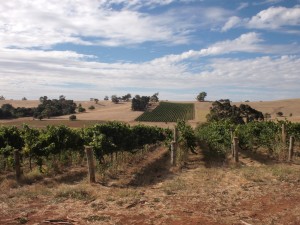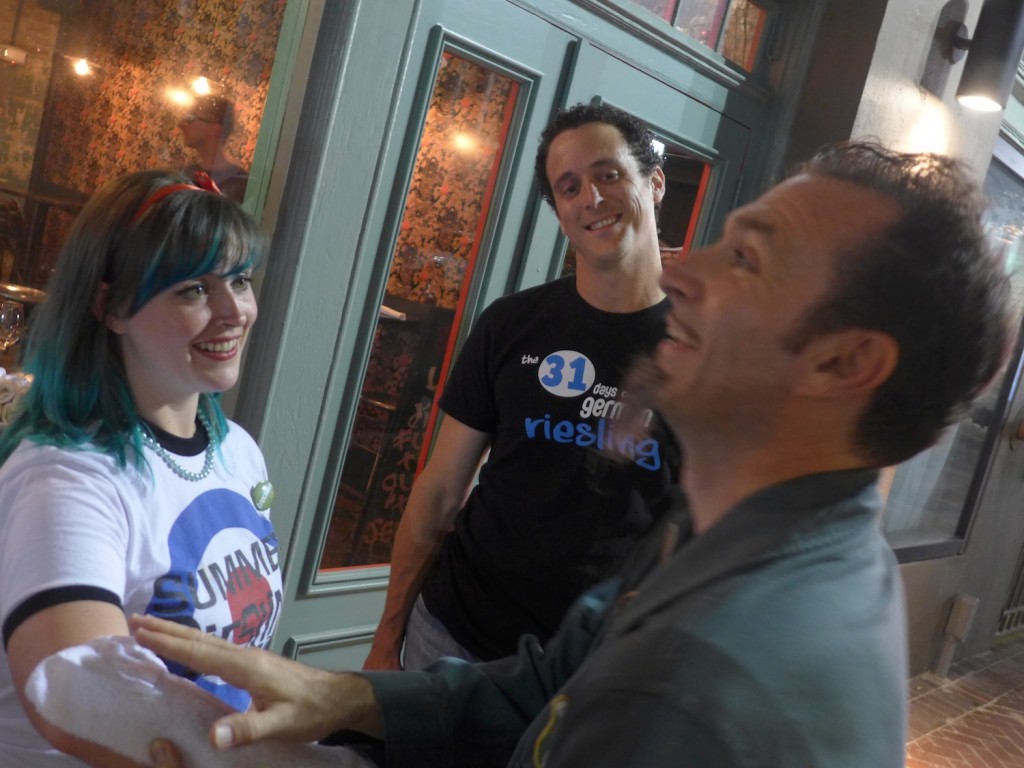Early this morning I ran in the French Quarter of New Orleans, the city which survived the double disaster of hurricane Katrina and George W. Bush’s callous lack of interest in the suffering it caused back in 2005. OK, it felt like running in a sauna under a powerful sun lamp, but that strikes me as a detail in the great scheme of things. In half an hour I saw as many residential properties dating back to the 18th century as the whole of Berlin/Germany has to offer. America may be a “New World”, but history is big in New Orleans!
However, as the Riesling Road Trip team and I found out last night at ‘Lucky Rooster’ – a new “Chinese” restaurant run by non-Chinese – the city is certainly not locked into a rear-view mirror thought mode. It was another inspiring tasting with a group of extremely switched-on, open-minded somms and wine retailers. The picture above shows Paul Grieco applying a Riesling tattoo to Lucky Rooster’s Cocktologist Christine Jeanine Nielsen.
A particularly big thank you goes to John Mitchell of Stella Restaurant in New Orleans/Louisiana for the coolest saying of the entire Riesling Road Trip: the angle of the dangle. Strange as that sounds this term requires a scientific explanation, though I promise to leave out all the jargon and the math.
 A lot has been talked about how Riesling is a cool climate grape and global warming might number Riesling’s days in Germany. However, Riesling is a much more adaptable grape than many people realize as its success in Clare Valley / South Australia proves. Clare Valley is actually hotter than Barossa Valley where so many of South Australia’s big Shiraz reds grow! Because the nights which follow the blistering Clare days are positively chilly, and temperatures during the final straight to the finishing line of harvest are rather cool Riesling has no fundamental problem. It will take a lot more global warming before anywhere in Germany is as hot as Clare Valley.
A lot has been talked about how Riesling is a cool climate grape and global warming might number Riesling’s days in Germany. However, Riesling is a much more adaptable grape than many people realize as its success in Clare Valley / South Australia proves. Clare Valley is actually hotter than Barossa Valley where so many of South Australia’s big Shiraz reds grow! Because the nights which follow the blistering Clare days are positively chilly, and temperatures during the final straight to the finishing line of harvest are rather cool Riesling has no fundamental problem. It will take a lot more global warming before anywhere in Germany is as hot as Clare Valley.
Then come all the things which the winegrower can do to influence conditions in the vineyard. Planting the vine rows North-South (as is normal in Germany) was a way of optimizing the exposure of the vines’ foliage (their solar panel). That was the logical approach in a climate where ripening the grapes fully was frequently a problem. However, the higher ripeness levels regularly being achieved today already makes this type of vineyard planting questionable, and further warming may make a reorientation absolutely necessary. By replanting the vines in rows with a Northeast-Southwest orientation you can pull down the temperature in the vineyard during the early afternoon (the hottest part of the day) by 4 – 5° Fahrenheit, which is very significant. So yes, the angle at which the Riesling grapes dangle in Germany is a crucial question for the future of these wines. Just like Global Warming that’s not just my opinion it’s hard science.
 As you can see I had a great time in New Orleans. In the car this morning to our next secret location I’m feeling a bit wasted, so I have to sign off now. But, before I do so I must let you know that Paul Grieco promised that next time we’re in the city he’ll organize a traditional New Orleans style funeral for Chardonnay including a Second Line (a parade). This promise is surely going to keep him at the top of the hit list of the Chardonnay International Army (CIA), so I wish him luck when the shit hits the fan.
As you can see I had a great time in New Orleans. In the car this morning to our next secret location I’m feeling a bit wasted, so I have to sign off now. But, before I do so I must let you know that Paul Grieco promised that next time we’re in the city he’ll organize a traditional New Orleans style funeral for Chardonnay including a Second Line (a parade). This promise is surely going to keep him at the top of the hit list of the Chardonnay International Army (CIA), so I wish him luck when the shit hits the fan.


![120114_riesling_global_RZ [1600x1200]](http://www.stuartpigott.de/wp-content/uploads/2013/06/120114_riesling_global_RZ-1600x120016.jpg)
Dumb,arrogante l’action sauf imaginer entre